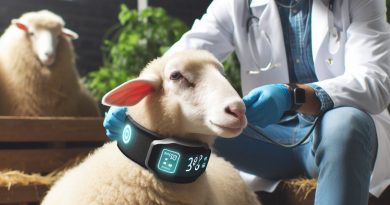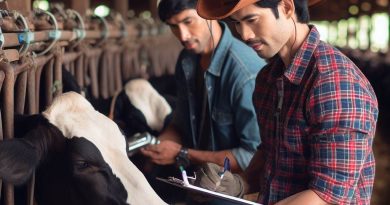Harvest Tech: Robotic Arms in Use
Last Updated on March 2, 2024
Introduction
Harvest technology plays a crucial role in modern agriculture, streamlining processes and increasing efficiency.
In this section, we will discuss the importance of harvest technology and focus on the topic “Harvest Tech: Robotic Arms in Use.”
Harvest technology has revolutionized the agricultural industry by automating various tasks, reducing labor costs, and enhancing productivity.
“Harvest Tech: Robotic Arms in Use” explores the application of robotic arms in agriculture, enabling precise and efficient harvesting.
Robotic arms equipped with advanced sensors and cameras can identify ripe produce and handle it delicately without causing damage.
These robotic arms can work tirelessly, without fatigue, thereby reducing the need for human labor and increasing overall productivity.
The use of robotic arms in harvest technology ensures consistent quality and increased yield, meeting the growing demand for food globally.
Furthermore, robotic arms can access hard-to-reach areas and work in challenging environments, such as extreme weather conditions, ensuring crops are harvested, regardless of external factors.
The integration of artificial intelligence and machine learning algorithms enables robotic arms to continually improve their performance and adapt to different crops and conditions.
Investing in harvest technology, particularly robotic arms, allows farmers to optimize resources, minimize wastage, and focus on other essential aspects of farming.
In fact, the use of robotic arms in harvest technology brings numerous benefits to modern agriculture, enhancing efficiency, productivity, and ensuring a consistent supply of high-quality produce. This section will delve further into the details and applications of robotic arms in harvesting.
Overview of Robotic Arms in Agriculture
Robotic arms have become increasingly prevalent in the field of agriculture, revolutionizing the way harvest tasks are performed.
These advanced machines offer a myriad of advantages that have led to increased efficiency, precision, and environmental benefits.
Robotic arms, also known as robotic manipulators, are mechanical devices that emulate the functionalities of a human arm in a controlled and automated manner.
In agriculture, these robotic arms are utilized to perform various tasks such as picking, pruning, and sorting crops.
A. Explanation of Robotic Arms in General
Robotic arms consist of multiple joints that enable them to perform a wide range of movements and tasks.
They are typically equipped with advanced sensors, cameras, and gripping mechanisms, allowing them to analyze and interact with the environment.
B. Advantages of Using Robotic Arms in Agriculture
Using robotic arms in agriculture offers numerous benefits that contribute to increased productivity, reduced costs, and improved sustainability. Some of the key advantages include:
The use of robotic arms in agriculture has gained momentum in recent years, transforming traditional farming methods and revolutionizing the industry.
Farmers and agricultural businesses are experiencing numerous benefits from the adoption of this technology.
With the ability to work tirelessly and efficiently, robotic arms maximize productivity and yield.
By carefully analyzing data from sensors and cameras, they can identify ripe crops, ensuring optimal harvesting time and preventing wastage.
Furthermore, the automation provided by robotic arms reduces the physical strain on farmers, improving their overall well-being and enabling them to focus on other important aspects of farm management.
When it comes to delicate crops or produce, robotic arms excel in handling them with utmost care.
Their gentle grip and pressure sensors prevent bruising or damage, ensuring a higher quality end-product.
In short, robotic arms have become an indispensable tool in modern agriculture.
With their enhanced efficiency, precision, and various other advantages, these machines have revolutionized the way harvest tasks are conducted.
As technology continues to evolve, we can expect even more advancements in this field, further transforming and improving our agricultural practices.
Read: Climate-Smart Agri-Tech Solutions for Farms
Applications of Robotic Arms in Harvesting
In recent years, the use of robotic arms in harvesting has gained significant prominence in the agriculture industry.
These advanced machines have revolutionized the way crops are picked and collected, bringing numerous benefits to farmers and laborers alike.
A. Robotic arms for harvesting crops
One of the primary applications of robotic arms in harvesting is for picking crops.
hese machines are designed to work efficiently and quickly, ensuring that the harvest is done effectively.
1. Fruit picking
Robotic arms have proven to be highly effective in fruit picking.
With their advanced sensors and gentle grip, they can identify ripe fruits and carefully pluck them without causing any damage.
2. Vegetable harvesting
When it comes to vegetable harvesting, robotic arms offer unmatched precision.
They can navigate through dense and challenging environments, selecting and picking vegetables with utmost accuracy.
3. Grain collection
Robotic arms have also found applications in grain collection.
With their ability to handle large volumes of grains, they make the process more efficient and less labor-intensive for farmers.
B. Challenges and Advancements in Robotic Arm Technology
1. Ability to handle delicate produce
One of the challenges in using robotic arms for harvesting is their ability to handle delicate produce without causing any damage.
However, advancements in technology have made significant progress in developing sensors and grippers that can ensure gentle and precise handling.
2. Adaptability to different crop varieties and sizes
Each crop variety has its unique characteristics and harvesting requirements.
Robotic arms need to be adaptable and adjustable to accommodate various crops’ sizes, shapes, and textures.
Researchers are continually working on developing versatile robotic arms that can handle diverse agricultural produce.
Overall, the introduction of robotic arms in harvesting has revolutionized the agriculture industry.
The applications of these advanced machines in crop picking, fruit picking, vegetable harvesting, and grain collection have made the process more efficient, cost-effective, and less labor-intensive.
Despite the challenges, significant advancements in robotic arm technology have addressed issues related to handling delicate produce and adaptability to different crop varieties and sizes.
These advancements have paved the way for further adoption and development of robotic arms in various agricultural activities.
As the demand for sustainable and efficient farming practices increases, the integration of robotic arms in harvesting is expected to expand further.
With ongoing research and development in this field, the future holds promising possibilities for increasing agricultural productivity and reducing dependency on manual labor.
In essence, the use of robotic arms in harvesting crops brings immense advantages to the agriculture industry.
The applications in fruit picking, vegetable harvesting, and grain collection have unlocked new opportunities for efficiency and productivity.
As technology continues to evolve, we can expect further advancements, making robotic arms an indispensable tool for farmers worldwide.
Read: Agri-Tech in Livestock Management: New Trends

Case Studies of Successful Implementations
In today’s blog section, we will explore the successful implementation of robotic arms in harvest technology.
Robotic arms have revolutionized various agricultural sectors, providing increased speed, accuracy, and cost reduction for farmers.
Let’s dive into two case studies showcasing the effectiveness of robotic arms in apple orchards and lettuce harvesting.
A. Robotic Arms in Apple Orchards
Robotic arms have significantly enhanced apple picking in orchards across the globe.
By utilizing this advanced technology, farmers have witnessed a remarkable increase in efficiency and precision.
1. Increased Speed and Accuracy in Apple Picking
Robotic arms excel in their ability to swiftly and accurately pick ripe apples.
Equipped with high-resolution sensors and sophisticated algorithms, these machines can identify the optimal time for harvesting, ensuring each fruit’s perfect ripeness.
2. Reduction in Labor Costs for Farmers
Traditionally, apple picking required a substantial workforce, leading to high labor costs.
However, with the implementation of robotic arms, farmers can reduce their reliance on manual labor.
These machines tirelessly work day and night, minimizing the need for human intervention and consequently lowering expenses.
B. Robotic Arms in Lettuce Harvesting
Robotic arms have also found success in the lettuce harvesting industry.
Their precise cutting capabilities have significantly improved crop quality while reducing waste.
1. Precision Cutting of Lettuce Heads
Robotic arms equipped with advanced imaging systems can identify the exact location and angle for cutting lettuce heads.
This precision ensures that each cut is clean and accurate, preventing damage to neighboring crops and improving the overall quality of harvested lettuce.
2. Improved Crop Quality and Reduced Waste
By employing robotic arms, farmers have observed a drastic reduction in crop waste.
The precise cutting technique eliminates unnecessary damage and minimizes post-harvest losses.
Additionally, the streamlined process ensures that only the highest-quality lettuce heads reach the market, increasing overall customer satisfaction.
In general, the utilization of robotic arms in harvest technology has proven to be immensely successful in both apple orchards and lettuce harvesting.
These case studies highlight the numerous benefits, including increased speed and accuracy in apple picking, labor cost reduction, precision cutting of lettuce heads, improved crop quality, and reduction in waste.
Robotic arms have truly revolutionized the agricultural sector, paving the way for a more efficient and sustainable future.
Read: Crop Monitoring Tech: Agri-Tech’s New Tools
Potential Future Developments
As the use of robotic arms in agriculture continues to grow, there are several potential future developments to look forward to.
A. Integration with artificial intelligence and machine learning
Robotic arms have already shown great potential in automating repetitive tasks, but imagine if they could also learn and adapt on their own.
By integrating artificial intelligence and machine learning algorithms into these robotic arms, they could become even more efficient and capable.
They could analyze data from sensors and make real-time adjustments to optimize performance.
B. Enhanced vision and sensing capabilities
One area of improvement for robotic arms is their vision and sensing capabilities.
Currently, they rely on cameras and sensors to detect and manipulate objects.
However, these technologies can be further enhanced.
By incorporating advanced computer vision algorithms and new sensing technologies, robotic arms could have improved object recognition and manipulation abilities.
C. Collaboration with drones and other automated machinery
Robotic arms have already proven useful in various tasks, but imagine if they could collaborate with other automated machinery.
For example, drones could be equipped with robotic arms to perform precision tasks such as pruning or harvesting in hard-to-reach areas.
This collaboration could lead to increased efficiency and productivity in agriculture.
D. Expansion of robotic arm applications in other farming tasks
While robotic arms are currently mainly used for tasks such as picking fruit or vegetables, their applications could expand to other farming tasks.
For example, they could be used for soil preparation, planting seeds, or even monitoring crop health.
With advancements in technology and the versatility of robotic arms, they have the potential to revolutionize various aspects of farming.
In review, the future of robotic arms in agriculture looks promising.
Integration with artificial intelligence and machine learning, enhanced vision and sensing capabilities, collaboration with drones and other automated machinery, and the expansion of their applications in other farming tasks are all potential developments to look forward to.
These advancements have the potential to increase productivity, reduce labor costs, and optimize farming practices.
With continued research and development, robotic arms will play a crucial role in shaping the future of agriculture.
Read: Water-Saving Tech in Agriculture: Startups to Watch
Gain More Insights: Robotic Tech in Agriculture: A Deep Dive
Conclusion
Robotic arms play a crucial role in harvesting, offering numerous benefits to the agriculture industry.
They are highly efficient and precise, resulting in increased productivity and reduced labor costs.
Moreover, robotic arms can perform tasks that are challenging and time-consuming for human workers, such as picking delicate fruits or working in extreme weather conditions.
This technology has the potential to revolutionize the future of agriculture.
As population growth continues, the demand for food will increase.
Robotic arms can significantly boost crop yield and help meet this demand.
They also have the potential to address labor shortages, as the agriculture industry often struggles to find enough workers for harvesting.
Embracing harvest technology is of utmost importance for the agriculture industry.
With climate change and other challenges, the need for efficient and sustainable farming practices is urgent.
Robotic arms offer a solution to improve productivity, reduce waste, and minimize the impact on the environment.
It is essential for farmers and agricultural businesses to embrace and invest in these technologies to secure a sustainable and prosperous future.

